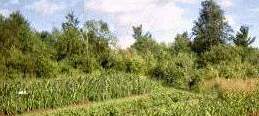
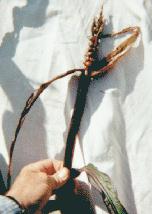
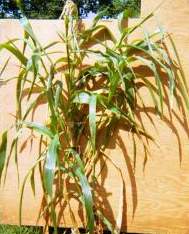
Corn is a member of the grass family. This group of plants includes lawn grasses and cereal crops like wheat and rice. Domestication of corn began over 7,000 years ago in the area that is now Mexico. The first "cobs" were about an inch long and looked like small heads of wheat with a tassle on top and a few leaves partially covering the kernels. Occassionally in corn breeding programs, small ears of corn are found that resemble primative corn (see photo left). The exact details of the ancestry of corn are still being worked out, but it is now widely accepted that a grass closely related to corn called "teosinte" (tey o sin te) played an important part in the development of corn. We know that teosinte (see photo right) still grows wild in Mexico today and crosses easily with corn. There is evidence from plant remains found in dry caves in Mexico that shows that teosinte was crossing with corn and that people were collecting and growing this corn thousands of years ago. Season after season, under the care of these native farmers, corn was planted and selected for more yield and larger ears. Today corn is a giant among the grasses and one of the most important crops in the world today.
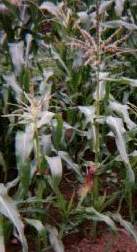
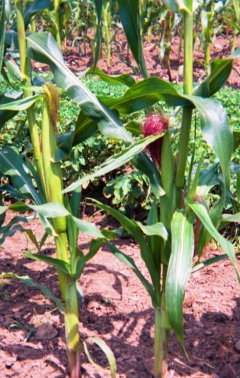
Corn is an open pollinated crop. The tassels at the top of the plant release pollen that is carried by the wind to the silks on ears of corn nearby. Each silk is connected to one kernel on the ear. Half of the genetic material of a future grain of corn is carried in the pollen. The other half of the genetic blueprint comes from the, as yet unfertilized, seed embryo on the ear. Once a pollen grain lands on the silk it grows down the silk to fertilize a seed (kernel) on the ear. The fertilized seed now contains the genetic material from both parents and begins to grow on the ear of corn. This is the time the ears are "filling out". If for some reason a grain of pollen does not fall on a silk then the kernel connected to that silk will not grow and there will be an empty space on that ear. Corn produces an incredible amount of pollen so there is usually more than enough pollen to fertilize all the kernels on each ear.
The kernels in a single ear on one corn plant can be very different from each other because the pollen that fertilized each kernal on that ear could have come from different corn plants. This is an important consideration in breeding corn. The plant that bears the ear only contributed half of the genes to the seeds, so selecting and planting seeds from ears of plants that have traits that you want will result in plants that only moderately resemble the parent that produced the ear. The pollen that fertilized the seeds of that ear could have come from many other plants with markedly different traits. This high level of diversity influences the way we approach corn breeding.

Rather than looking at crop of corn as a collection of individual plants, corn breeders find it more useful to view a corn population as a gene pool. A gene pool is a collection of all the genes (genes control traits) in the corn population. Breeding programs change the relative number of certain genes in a gene pool by selection. For example, if you select for a certain color of kernel, you can increase the number of genes for that color in the gene pool. You may not be able to predict that a certain individual plants will have that trait, but you can predict that the total number of plants with that trait in the population will generally increase because the relative number of genes in the gene pool for that trait will increase. It is important to be aware that when you increase the relative number of genes for one trait, (a particular color in this case) other color genes will become less common in the gene pool. So as you change the mixture of genes in a breeding population you make some genes more common and others less common. All breeding programs are a trade off between the advantages and disadvantages in increasing some traits and decreasing others.
Let's see how this works. If you start with a breeding population of corn (or any open pollinated species) and plant out 1000 plants of a variety that has a lot of diversity in its background even though many plants in the population will look similar we can be pretty sure that no plants are exactly alike genetically. Some plants may respond better to cold that others. Some respond better to drought that others. Some grow faster. Some have larger ears. Some resist being blown over by the wind better than others. Now let's see what happens by growing the plants in a test plot.

If during our test period we have a very dry summer with long periods of intense heat without rain, then some plants will handle these conditions better than others. Some plants in our population may have root systems that are particularly well developed. Others may have extra waxy leaves that hold moisture better. In a severe drought many of the stressed plants may produce smaller ears or in some cases no ears at all. Other plants that are better able to handle drought conditions many produce ears near normal size. At the end of a season if we did no selection at all and only picked all the ears that formed and mixed all the seeds from all the ears in one big batch and stirred it all up we would have our current gene pool for the next season. The is the same process that takes place in natural selection. Each season in a population of wild plants certain plants in a population do better than others and produce more seed than its neighbors. The mixture of genes in a gene pool in an open pollinated variety (wild or domestic) changes from season to season. In our case the individual plants that have combinations of genes that helped them grow better in drought conditions contributed more ears (kernels and genes) to the seed mixture than those plants that had a hard time with the dry conditions and produced small or no ears. The gene pool has changed with more genes in the gene pool that have favorable effects in drought conditions. If we have a number of years in a row of dry conditions, then the gene pool will have a mixture of genes that has many more genes in the gene pool that help survive drought conditions that it did when we started. This is how selection works. The population of plants in a gene pool (a breeding population) of cross pollinated plants will gradually adapt to the conditions that are common to an area. That is how we get drought resistance varieties of corn like that native americans grew in the south west United States or how natural selection for drought resistance produced plants like the catus.

The great thing about breeding a open pollinated plant variety like corn is that natural selection is happening all the time and the mixture of genes in the gene pool is changing towards a corn that is better adapted to your growing conditions. A good breeding program should take advantage of this natural selection. Sometimes you can even speed up the process by careful selection and by using a methods that control what seeds go into your seed mixture (gene pool). The easiest step is to change the proportions of seeds. For example, in our drought breeding experiment, we could select the best 80 plants for producing good ears during a drought and put all these seeds in a bag. Then take all the other seeds from all the other ears and put only 1/2 of the seeds from each of these ears in the bag. This will mean we will have a much higher proportion of drought resistant seeds in the seed mixture than we would have if we had mixed all the seeds in one bag. We have boosted the percentage of drought resistant genes in the gene pool. At the same time we were careful not to throw out all the genes in the plants that did not appear to do as well in the drought as the best producing plants. Remember we are not trying to get rid of a lot of genes we only want to change the proportions of genes in the population. Generally our method has allowed all the genes to be represented in the population, we just changed the percentages in favor of the drought resistance ones.

You may wonder why we didn't just plant only the most drought resistant ears and forget all the others. The reason is: Genetic diversity. If we plant a really small number of plants (say 10 plants of corn) we will not have all the different types of genes in the population represented in our gene pool. Certain genes (some for drought resistance, for example) may by chance not be present in our 10 plants. That means that we will loose those genes forever from our gene pool. Even if we plant 100 plants from the ears of our 10 plants the following year we will not see those lost genes again. This is how genetic drift occurs. The gene pool in a plant population can drift (by chance) through loss of genes and the characteristics of the plants will change because some genes were lost from the gene pool. This will lead to much less diversity in the gene pool and eventually to inbreeding depression. Once you reach the point of inbreeding depression the yield of the plants will actually go down even though you were selecting what you thought were the "best" plants. In corn, it is generally estimated that you need to save seed from at least 200 plants to avoid inbreeding depression. I prefer to stay well above this level (say 1000 to 1500 plants) except under certain conditions.
Why be so careful? Besides the obvious dangers of genetic drift and inbreeding depression, you need to be aware that when you select for one trait you may be selecting against other traits. In our example, during a period of drought we selected for drought resistant traits. If we take only the best drought resistant plants and grow only those plants in the next generation. What happens if we enter a cycle of really wet years? By selecting so strongly for drought resistant traits we may have lost or greatly reduced some genes that would be useful in a wet season. For example, wet conditions in corn can favor certain diseases like corn rust. If we selected too strongly for drought resistance we could have lost some genes that may have given resistance to rust. If we increase certain genes in the gene pool by selecting for certain traits and are careful to keep a diversity in the gene pool we can have traits that are useful for our conditions AND have enough diversity in the gene pool to adjust to unexpected changes. That is the goal of our breeding program.

"Maize is a member of the grass family, Poaceae. Unlike most other grasses, it
has separate staminate and pistillate flowers borne terminally and laterally,
respectively. This separation ensures a high degree of cross pollination.
Although individual plants are usually pollinated by close neighbours, they
may be up to one km away. Pollination begins about one to three days prior to
silk (stigma) emergence (on the same plant) and continues three to four days
after the silk becomes receptive. Fertilization occurs about 24 hours after
pollination. However, pollen is heat-sensitive and is killed at temperatures
greater than 35C. A 90% reduction in viable pollen isn't likely to be a threat
to normal pollination because of the sheer quantity of pollen production but
can be devastating to breeding programs. In addition, during severe drought,
shoot emergence may be delayed and, in combination with early termination of
pollen shedding, may result in failure to set seed. Ear shoots arise from
nodes approximately half-way up the stalk. Each shoot is composed of a shank
(gives rise to husk) and a cob (pistillate flowers). Spikelets occur in pairs
and give rise to one sterile and one fertile ovule. Fertilization of the
second ovule results in irregular, crowded rows of kernels. "
Flowering
and Pollination - McGill University
"ORIGIN OF CORN
Corn (Zea mays L.) is the only important cereal indigenous to the Western Hemisphere. Apparently originating in Mexico, it spread northward to Canada and southward to Argentina. While the possibility of secondary centers of origin in South America cannot be completely ruled out, the oldest (7000 years) archaeological corn was found in Mexico's Valley of Tehuacan.
The earliest "corn" of which there is record is unmistakably corn. The female inflorescence of this 5000 B.C. corn had reached a degree of specialization that precluded the possibility of natural seed dissemination. Thus, the oldest corn of record was dependent upon man for its survival.
Numerous theories of origin have been offered over the years, only two of which receive serious consideration today. One is that teosinte (Zea mexicana) is the wild progenitor of corn; the other is that a wild pod corn, now extinct, was the ancestor of domesticated corn. While perhaps more students of corn seem to accept the first theory, others are equally convinced of the second.
Aside from its possible role in the origin of corn, teosinte has had
major impact on its evolution. In Mexico particularly, introgression
between corn and teosinte has likely occurred for centuries and
continues to this day. The effects are apparent in the morphology
and cytology of both species. There is also reason to believe that
genes for resistance to certain viruses have reached corn through its
introgression with teosinte."
Origin, Adaptation, and Types of Corn - Purdue University -
Cooperative Extension Service
"DURHAM, N.C. -- Scientists continue to debate the ancestry of domesticated corn. But Duke University researcher Mary Eubanks said she has mounting evidence that corn emerged from the interbreeding of two different wild American grasses.
Those grasses are Tripsacum dactyloides, also known as Eastern
gamagrass, and Zea diploperennis, a perennial variety of teosinte. By
successfully crossing them for the first time, Eubanks has produced fertile
offspring that closely resemble the earliest known samples of primitive
domesticated corn, she said in a recent interview.
"
New
Evidence For Corn's Ancestry - Duke University
"Characteristics of Maize's Wild Ancestor {Compared To Corn}
Origins of Maize
* many stalks (has been reduced to one)
* mechanism for dispersal of seeds (none now)
* fewer husks - related to shorter shank (now, more husks fully enclosing the
ear)
* many spikes - the upper with staminate and pistillate flowers
(now, single lower ear with only pistillate flowers)
* kernels enclosed
by floral bracts or glumes (glumes now absent)
* smaller ears
*
short or absent leaf blades (now, longer) "
Maize's
Wild Ancestor - Mcgill University
"Variability and Races
Regardless of origin, corn has proven to be one of the most
adaptable and variable members of the grass family. Its evolution, a
large part of which apparently occurred under domestication, has
resulted in biotypes with adaptation ranging from the tropics to the
north temperate zone, from sea level to 12,000 feet altitude and
growing periods (planting to maturity) extending from 6 weeks to 13
months."
Origin, Adaptation, and Types of Corn - Purdue University -
Cooperative Extension Service
"Dent Corn
The U.S. Corn Belt dents originated from the hybridization of the Southern Dent or late-flowering maize race called Gourdseed, and the early- flowering Northern Flints. Dent corn is characterized by the presence of corneous, horny endosperm at the sides and back of the kernels, while the central core is a soft, floury endosperm extending to the crown of the endosperm where, upon drying, it collapses to produce a distinct indentation. Degree of denting varies with the genetic background. Nearly all varieties grown in the U.S. are yellow, with only a few white endosperm types grown.
Flint Corn
The flint corns mostly have a thick, hard, vitreous (glassy) or corneous endosperm layer surrounding a small, soft granular center. The relative amounts of soft and corneous starch, however, vary in different varieties. Generally, the kernels are smooth and rounded, and the ears long and slender with a comparatively small number of rows or kernels. In temperate zones, flint corn often matures earlier, germinates better, has more spring vigor, more tillers and fewer prop roots than dent strains.
Flour Corn
This is one of the oldest types of corn, tracing back to the ancient
Aztecs and Incas. American Indians ground the soft kernels for
flour. Floury maize types have soft starch throughout, with
practically no hard, vitreous endosperm and thus are opaque in kernel
phenotype. Kernels tend to shrink uniformly upon drying, so usually
have little or no denting. When dry, they are easy to grind, but may
mold on the mature ear in wet areas."
Origin, Adaptation, and Types of Corn - Purdue University -
Cooperative Extension Service
"Cross-Pollinated Methods
As a consequence of cross-pollination, the genes are reshuffled each generation and regrouped into new genetic combinations.
With an almost limitless number of gene combinations possible within the gene pool, there is almost never two plants that could be found with identical genotypes.
But, under natural environmental conditions - cross-pollinated populations are relatively fluid (r) genes favoring adaptation and improved seed production tend to increase at the genes that are unfavorable for adoption or fitness to reproduce.
In populations in breeding populations, the shift towards more adapted genotypes may be accelerated by selection and by environmental stresses to which the breeding populations are being selected."
"A major difference between self and cross pollinated species is that in cross-pollinated crops the focus of the breeder is on populations instead of individual plants AND more emphasis is given to quantitative.
..................Breeding procedure for cross-pollinated crops are based primarily on population improvement schemes.
This means we try to increase the frequency of genes in the population that contribute to the desired breeding objectives."
"Breeding Open-Pollinated Corn
Open pollinated corn is heterozygous and heterogeneous. The likelihood of two kernels on a cob, or even in a field, possessing the same genotype is very low.
Mass selection
There are several problems with mass-selection:
In order to maximize the effectiveness of selection, emasculation of
visibly inferior plants before pollen shed is useful for some traits. Also,
because environment plays an important role in the phenotypic response of a
plant, the field can be divided into smaller sub-plots. Selection is then
limited to the best ear per sub-plot regardless of phenotypes outside each
respective sub-plot."
Breeding
Open-Pollinated Corn - Mcgill University
"INBREEDING DEPRESSION AND HYBRID VIGOR
The negative effects of inbreeding are referred to as inbreeding depression.
The classic example is in maize. For the first 8 to 10 generation of
inbreeding, the height of maize inbreds decreases with each cycle. Then, the
height levels off, and the inbreds (although not as vigorous as the original
plant) stabilize. "
Inbreeding
Depression And Hybrid Vigor - Genetics for Seed Savers
"Inbreeding Depression In Plants And Its Consequences
In the eighteenth century, Thomas Knight showed
that progeny of inbred plants were less vigorous and produced less seed than
those of outcrossed plants (Holsinger, 1991). Darwin (1876) noted that,
"Nature...abhors perpetual self fertilization." The numerous
mechanisms developed by plants to prevent self-fertilization were viewed as
evidence of its deleterious nature. Scientists and naturalists believed that
inbreeding reduced genetic variation, reducing the ability of a species for
long term adaptation.
"
Inbreeding
Depression In Plants And Its Consequences - Department of Biology - West
Virginia University
"Avoiding Inbreeding Depression in Corn
A prime consideration when growing corn for seed is the size of the 'parent' planting. Corn represents an extreme example of the necessity for growing a large enough number of plants to avoid 'inbreeding depression'. Inbreeding depression-weakening of a population by too-narrow a genetic base-is a direct result of collecting seed from too few parents. Once a batch of seed is produced from too few parents, the genetic base of that group of seeds is permanently narrowed unless new genetic material can be introduced. Thus, an inbred seed batch's genetic base can be broadened by mixing the batch with a healthy batch of the same variety grown by a different grower. Inbreeding is better avoided than 'fixed', however. Grow at least 200 corn plants to avoid inbreeding depression. Remember to collect some seeds from each plant, and make sure that at least 200 plants are included in the planting, with at least 100 allowed to produce seed. An adequate planting of seed-corn should start with 250 or so seeds, and care should be taken not to let a planting fall to too few plants for continued genetic vitality. If too-few plants survive
Among plants which reproduce sexually, collecting seeds from too-few parents can result in dangerous narrowing of a variety's genetic base. The resultant weakening of the variety is called "inbreeding depression". Since each individual plant typically does not contain all the available genes belonging to the variety, some minimum number of plants is needed in order to maintain the diversity and vigor of the variety.
The degree of danger from inbreeding depression, and the number of parent plants needed to avoid it, depends on several factors. One factor is the variability of the variety^the greater the variation between individual plants in a population, the more plants will be needed to preserve their collective genetic base.
A plant notable for needing a particularly-large parent population for
long-term breeding health is corn, which needs at least 200 parent plants
to produce healthy seed batches."
Vegetable Seed Savers Handbook - Seeds of Texas - Seed Exchange
"This long-term laboratory
experiment examines the negative effects of inbreeding on fitness (See Link)...
"
Inbreeding Depression and the Evolutionary Advantage of
Outbreeding - University of Toronto